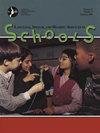发展性语言障碍西班牙语学生的对话阅读策略与词汇:个案研究
IF 2.9
3区 医学
Q1 AUDIOLOGY & SPEECH-LANGUAGE PATHOLOGY
Language Speech and Hearing Services in Schools
Pub Date : 2025-08-22
DOI:10.1044/2025_lshss-25-00004
引用次数: 0
摘要
目的本研究的目的是比较双语(西班牙语和英语)和纯英语的对话阅读策略(DRS)对有发展性语言障碍(DLD)的学龄双语学习者(dls)词汇习得的效果。方法5名年龄在5至8岁之间,确诊或疑似患有dld的参与者(N = 5)参加了这项适应交替治疗设计的调查。第一因变量为英语词汇命名,第二因变量为西班牙语词汇命名。参与者接受了为期5周的DRS干预,可选择单独或小组形式,以英语和双语形式进行共享阅读。结果在引入两种治疗条件后,每位受试者的英语词汇命名能力均有显著提高。然而,DRS的双语版本更有效,因为所有五名参与者在干预期间不仅学习了英语单词(第二语言[L2]),还学习了西班牙语词汇(第一语言[L1])。结论本研究提供的证据表明,双语教学法是一种实用和有效的方法,可以增加母语和第二语言的词汇量。需要进一步的研究来检验这种干预对那些表现出更广泛的语言和学术需求的讲西班牙语的dll的影响,就像特殊教育独立班级的学生一样。本文章由计算机程序翻译,如有差异,请以英文原文为准。
Dialogic Reading Strategies and Vocabulary in Spanish-Speaking Students With Developmental Language Disorder: A Single-Case Research Study.
PURPOSE
The purpose of this investigation was to compare the efficiency of dialogic reading strategies (DRS) provided bilingually (Spanish and English) and solely in English on the acquisition of vocabulary by young school-aged dual-language learners (DLLs) with developmental language disorders (DLD).
METHOD
Five participants (N = 5) between the ages of 5 and 8 years, identified with or suspected of having DLDs, participated in this adapted alternating treatment design investigation. The primary dependent variable (DV) was English vocabulary naming, and the secondary DV was Spanish vocabulary naming. Participants received 5 weeks of shared book reading with DRS intervention alternatively in English only and bilingually, either individually or in a small-group format.
RESULTS
Each participant exhibited a noticeable increase in English vocabulary naming after introduction of both treatment conditions. However, the bilingual rendition of the DRS was more efficient because all five participants learned not only English words (second language [L2]) but also Spanish (first language [L1]) vocabulary during the intervention.
CONCLUSIONS
This study provides evidence that a bilingual approach to DRS is a practical and efficient way to increase vocabulary in both L1 and L2 when used to treat young school-aged DLLs with DLDs. Further research is needed to examine the effects of this intervention on Spanish-speaking DLLs who present a broader range of linguistic and academic needs, as is the case for students in special education self-contained classes.
求助全文
通过发布文献求助,成功后即可免费获取论文全文。
去求助
来源期刊

Language Speech and Hearing Services in Schools
Social Sciences-Linguistics and Language
CiteScore
4.40
自引率
12.50%
发文量
165
期刊介绍:
Mission: LSHSS publishes peer-reviewed research and other scholarly articles pertaining to the practice of audiology and speech-language pathology in the schools, focusing on children and adolescents. The journal is an international outlet for clinical research and is designed to promote development and analysis of approaches concerning the delivery of services to the school-aged population. LSHSS seeks to advance evidence-based practice by disseminating the results of new studies as well as providing a forum for critical reviews and meta-analyses of previously published work.
Scope: The broad field of audiology and speech-language pathology as practiced in schools, including aural rehabilitation; augmentative and alternative communication; childhood apraxia of speech; classroom acoustics; cognitive impairment; craniofacial disorders; fluency disorders; hearing-assistive technology; language disorders; literacy disorders including reading, writing, and spelling; motor speech disorders; speech sound disorders; swallowing, dysphagia, and feeding disorders; voice disorders.
 求助内容:
求助内容: 应助结果提醒方式:
应助结果提醒方式:


